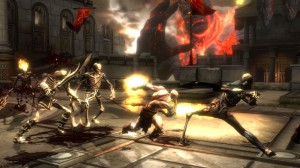By Erik Sofge www.popularmechanics.com
When the Burj Khalifa was completed earlier this year in Dubai, it became more than just the tallest building in the world.
 At 2717 feet it towers above the competition—it’s more than two and a half times the size of the Chrysler tower, and while the previous top five highest buildings were all within a couple of hundred feet of each other, the 160-story Burj Khalifa beats the old world-record-holder, the Taipei 101, by some 900 feet. For size-conscious architects, the gauntlet hasn’t been thrown. It has been launched into space and threatens to blot out the sun.
At 2717 feet it towers above the competition—it’s more than two and a half times the size of the Chrysler tower, and while the previous top five highest buildings were all within a couple of hundred feet of each other, the 160-story Burj Khalifa beats the old world-record-holder, the Taipei 101, by some 900 feet. For size-conscious architects, the gauntlet hasn’t been thrown. It has been launched into space and threatens to blot out the sun.
In the video-game world, the most impressive architecture is the living, breathing kind; vast monsters that dwarf your on-screen protagonist. When they’re the enemy, these digital heirs to the Krakens and Leviathans of classic mythology are called bosses. And they appear to be getting bigger. Remember King Koopa, the princess-kidnapping, turtle-like despot of Super Mario Bros? He might have topped out at 12 or 13 feet on a good day. In games like 2005’s Shadows of the Colossus and 2008’s Resistance 2, bosses measure in the hundreds of feet, with increasingly realistic in-game physics to govern their virtual mass.
Let those brutes toil in the hundreds. When God of War III comes out on Tuesday, March 16, for the PlayStation 3, gaming will have its own Burj Khalifa—Kronos, the 1600-foot-tall boss. Giant creatures are a staple of the God of War series, and there are other Titans in this game, which depicts their mythological war with the Greek gods. The first God of Warfeatured a duel between the 7-foot-tall protagonist, Kratos, and a massive Hydra. The sequel upped the ante with a centerpiece battle with the Godzilla-size Collossus of Rhodes. But even that stone behemoth was just one-sixth the size of Kronos, according to God of War III‘s lead programer, Vassily Filippov. And no matter how much bigger the enemies have gotten, comparing raw numbers doesn’t do the new game justice, Filippov says. “Back then, the large characters that we had were essentially a backdrop set piece. Now, they are part of the environment that you interact with,” he says. “They have pliable skin that bends, and you can climb on that skin. There are new types of gameplay that weren’t possible with the previous hardware.”
At the risk of banging an old and extremely battered drum, God of War III‘s use of scale is another example of a technical trick that, according to Filippov, only the PlayStation 3 can pull off. Although previous games, including God of War titles, have featured large enemies, the new game’s Titans are presented not as scripted events or optical illusions. They are fully-rendered, exceptionally detailed character models, with stable proportions (Kronos’s hand doesn’t simply swell as it approaches, as the Colossus’s hand did) and shifting textures that push the limits of the PS3’s hardware. Although the Kronos fight was a technical challenge, a sequence where Kratos travels the length of the Titan Gaia was even more complicated. “The Gaia scene is an example of something that wouldn’t fly on the [Xbox] 360,” Filippov says. “The reason is you need to recalculate that entire surface—all of Gaia’s skin—and you need to calculate collisions for all the dozens of enemies climbing on and sticking to that surface.”
In that particular scene, Kratos has to navigate the craggy, earthen skin and foliage covering Gaia, as up to two dozen enemies at a time make their own way around the Titan’s body features to attack him. This is where the PS3 shines, Filippov says. As Gaia’s body moves (she’s locked in her own fight, even as you’re fighting across her) the Titan’s skin conforms to those movements, textures shift, and the enemies’ artificial intelligence reassesses the best path to take. Each of Gaia’s actions forces a recalculation of the entire environment and the characters that inhabit it. In fact, what might be the most impressive feat yet of the console’s famous synergistic processing units, or SPUs, is what you don’t see—limbs and blades drifting through the wildly changing environment. The entire scene, which includes multiple moments when the camera zooms out until Kratos is barely a pixel in size, features realistic collision detection, as dirt, trees, leaves and combatants (both titanic and comparatively tiny) crash into each other. The result is a scene that not only tops every previous game in terms of epic-scale characters, but uses the PS3’s much-vaunted processing power to focus on, quite literally, a million minute details. After all, it’s not the size that matters. It’s the number of SPUs you have handy to constantly recalculate it.












